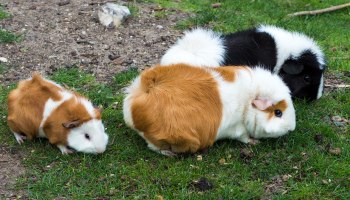Guinea pigs and hamsters are popular small pets but require extra care. Before deciding if a guinea pig can live in a hamster cage, it is essential to understand the needs of each animal. In this blog post, we will explore if a guinea pig can live in a hamster cage and what considerations should be considered when making this decision.
Here’s a detaild guide publish on Lumbuy, You should also Read it!
The minimum recommended size for a guinea pig cage is 7.5 square feet.
This is a significant factor to consider when housing a guinea pig. Although this may sound like a small space, it is large enough for them to move around and exercise. Guinea pigs need plenty of room to roam, which is essential for their overall health and well-being. Anything smaller than 7.5 square feet can be considered too cramped, and the guinea pig will need more time to exercise.
A guinea pig cage should be at least 7.5 square feet to allow them to move around and play. This site should also provide adequate access to hay, fresh vegetables, water, and places to hide and play. With this amount of space, you can provide your guinea pig with the necessary environment for healthy living.
A hamster cage typically only offers 1-2 square feet of space
Hamster cages are generally much smaller than the recommended size for a guinea pig cage. The minimum recommended size for a guinea pig cage is 7.5 square feet, while a hamster cage typically only offers 1-2 square feet of space. This means a guinea pig will not have enough room to move around, exercise, and explore in a hamster cage.
Guinea pigs need plenty of space to move around and explore to remain healthy and active. They also need plenty of hay, fresh vegetables, and water to stay healthy. However, a hamster cage may need more space for these items, making it difficult for a guinea pig to live comfortably in a hamster cage.
Guinea pigs need more space to move around and exercise.
Guinea pigs are highly active animals and need ample space to move around and exercise. They need an enclosure of at least 7.5 square feet and preferably larger. Guinea pigs cannot jump or climb, so you need to provide them plenty of space to move freely. With enough room, they can adequately explore their environment, exercise their bodies, and engage in activities stimulating their natural behavior.
In the wild, guinea pigs can roam over hundreds of acres, which is impossible in a domestic environment. Therefore, you must provide your pet guinea pig with plenty of room to move around and exercise. Otherwise, they will be unable to lead a healthy life.
Guinea pigs also need access to hay, fresh vegetables, and water
Providing fodder to your guinea pig is essential to their health and well-being. Grass provides roughage that helps their digestive system to function correctly, as well as helps to keep their teeth in check. The ideal type of hay for guinea pigs is Timothy hay, but they can also eat a variety of grass hays such as orchards, meadows, and oat hay.
In addition to hay, fresh vegetables are an essential part of a guinea pig’s diet. Vegetables provide essential vitamins and minerals for their growth and development. Examples of safe vegetables for guinea pigs include kale, bell peppers, celery, carrots, and cucumbers. You should always avoid giving your guinea pig starchy vegetables like potatoes or corn.
Finally, fresh water is necessary for all animals, including guinea pigs. Make sure to change the water in your guinea pig’s cage daily to ensure it is clean and free of bacteria. If you don’t want to replace the water daily, you can get a bottle with a built-in drinking spout to keep the water clean and fresh.
Conclusion
Hamster cages do not offer enough space for a guinea pig to move around, exercise, and explore, as guinea pigs need at least 7.5 square feet of space to do so. Hamster cages typically only offer 1-2 square feet of space, which is not enough for a guinea pig. Additionally, guinea pigs need access to hay, fresh vegetables, and water, which hamster cages do not provide. Therefore, if you have a guinea pig, it is best to invest in a larger cage that can accommodate its needs and provide them with a comfortable living environment.










